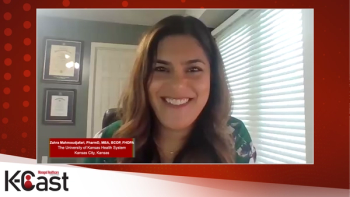
Intervention to Address Financial Toxicity Improves Blood Cancer Survival, Quality of Life
Results show that the mortality risk was cut in half for patients who got help with the financial burden of their care. Quality of life scores also improved.
Financial toxicity is a very real concern of a large number of patients, particularly those with hematologic malignancies such as leukemias,
Knight and his colleagues recently conducted a pilot study that identified patients at a high risk of experiencing financial toxicityand then tested whether an intervention improved clinical outcomes. The results were
The financial burden associated with cancer care is increasingly recognized as a major determinant of outcomes in all tumor types, Knight wrote in JCO Oncology Practice. The term, “financial toxicity,” was coined to emphasize that financial burdens have clinical consequences in the same way the physical toxicities associated with these treatments do.
“You can have the best and most advanced treatments in the world, but if patients are unable to receive them due to cost/transportation or other concerns, then it does not matter,” Knight said. “The other thing that is very important to note for blood cancer patients, is that their diseases keep them in an incredibly immunosuppressed state requiring multiple medications to keep them safe. Additionally, these diseases are incredibly aggressive with average survivals without treatment of usually less than six months.”
If patients are having financial problems and they're not able to get their chemotherapy or prophylactic medications or go to their doctors’ visits, the consequences can be “devastating,” Knight stressed. “Therefore, it was incredibly important to both define the problem in this vulnerable population and look at ways we can help.”
The research into financial toxicity and the hematologic malignancies has been limited, Knight told MHE. Most of the major studies of financial toxicity have been of patients with solid tumors (breast, lung, colon cancer and so on) because they are far more prevalent than the blood cancers, he said.
However, the Leukemia and Lymphoma Society started to fill that void with a study of blood cancer patients. That study found that patients had a cumulative average allowed spending (defined as costs paid by payers and patients combined, ranging from $200,000 for chronic leukemias to more than $800,000 for acute leukemias in the first 36 months of treatment.
In comparison, the cumulative average allowed spending for lung cancer was $250,000 and $150,000 for colorectal cancer.
Knight and colleagues screened 683 patients at the Levine Cancer Institute's Leukemia Clinic between May 2019 and March 2020. The patients had acute myeloid leukemia, myelofibrosis,acute lymphocytic leukemia and other types of hematologic cancers. Patients were asked to agree (or disagree) on a five-point scale with two statements, “I know that I have enough money in savings, retirement, or assets to cover the costs of my treatment” and “I am satisfied with my current financial situation”.
Then, the patients were enrolled in comprehensive intervention to address financial toxicity, which included nurse navigators, clinical pharmacists and financial planners who worked pro bono.
The researchers found that about one-third (35.6%) of the patients they screened were experiencing financial toxicity, although they caution that their screening questions have yet to be validated. The patients experiencing financial toxicity also had higher rates of noncompliance with all aspects of their care, including 17% who missed doses of prescription medications because they could not afford them, Knight said. In addition, 16% of them did not take recommended OTC medications.
“This is a very concerning finding in this high-risk population that cannot afford to have any delays in treatment,” Knight stressed.
The research team’s nurse navigators and social workers found funding from grants for more than one-third of the patients experiencing fin with a median total value of $850 (the range was $100 to $17,850 per patient). They also found other assistance such as gas cards, food pantry assistance, and transportation assistance that tallied up to a median value of $300.
Clinical pharmacists obtained free or greatly cost-reduced medications for the qualified patients at a savings of $197,158 per patient More than half (54.2%) of the patients opted to receive one-on-one counseling with a pro bono financial planner.
Notably patients receiving the intervention were 56% less likely to die than patients in the control group, over a one-year period.
In addition, patients with financial toxicity who received the intervention had a “significantly higher quality of life” measured by PROMIS Physical and Mental scores.
“One thing that we did not expect is that we saw both increased mental and physical quality of life with this intervention. We expected mental as we reduce the stress from financial concerns. However, our patients reported tremendous physical improvement as well,” Knight said.
Knight said there needs to be increased focus on screening patients with hematologic malignancies for financial toxicity. He said his research showed that even at a busy clinic, a two-question screening test could identify people in danger of experiencing financial toxicity from cost of their cancer care.
”Focusing resources in this area can lead to very real benefits for patients as we demonstrated both increased quality of life for all of our patients and decreased the risk of death in our high-risk disease group,” he added.
Newsletter
Get the latest industry news, event updates, and more from Managed healthcare Executive.


















































